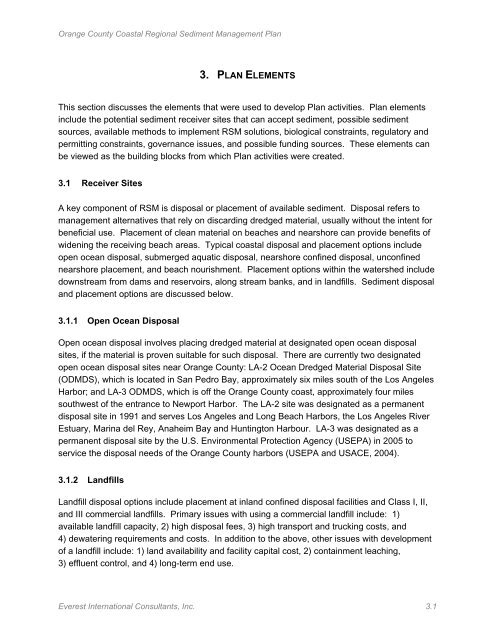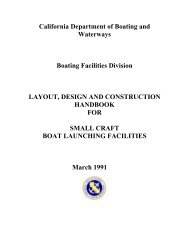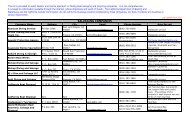EVEREST June, 2013 - California Department of Boating and ...
EVEREST June, 2013 - California Department of Boating and ...
EVEREST June, 2013 - California Department of Boating and ...
You also want an ePaper? Increase the reach of your titles
YUMPU automatically turns print PDFs into web optimized ePapers that Google loves.
Orange County Coastal Regional Sediment Management Plan<br />
3. PLAN ELEMENTS<br />
This section discusses the elements that were used to develop Plan activities. Plan elements<br />
include the potential sediment receiver sites that can accept sediment, possible sediment<br />
sources, available methods to implement RSM solutions, biological constraints, regulatory <strong>and</strong><br />
permitting constraints, governance issues, <strong>and</strong> possible funding sources. These elements can<br />
be viewed as the building blocks from which Plan activities were created.<br />
3.1 Receiver Sites<br />
A key component <strong>of</strong> RSM is disposal or placement <strong>of</strong> available sediment. Disposal refers to<br />
management alternatives that rely on discarding dredged material, usually without the intent for<br />
beneficial use. Placement <strong>of</strong> clean material on beaches <strong>and</strong> nearshore can provide benefits <strong>of</strong><br />
widening the receiving beach areas. Typical coastal disposal <strong>and</strong> placement options include<br />
open ocean disposal, submerged aquatic disposal, nearshore confined disposal, unconfined<br />
nearshore placement, <strong>and</strong> beach nourishment. Placement options within the watershed include<br />
downstream from dams <strong>and</strong> reservoirs, along stream banks, <strong>and</strong> in l<strong>and</strong>fills. Sediment disposal<br />
<strong>and</strong> placement options are discussed below.<br />
3.1.1 Open Ocean Disposal<br />
Open ocean disposal involves placing dredged material at designated open ocean disposal<br />
sites, if the material is proven suitable for such disposal. There are currently two designated<br />
open ocean disposal sites near Orange County: LA-2 Ocean Dredged Material Disposal Site<br />
(ODMDS), which is located in San Pedro Bay, approximately six miles south <strong>of</strong> the Los Angeles<br />
Harbor; <strong>and</strong> LA-3 ODMDS, which is <strong>of</strong>f the Orange County coast, approximately four miles<br />
southwest <strong>of</strong> the entrance to Newport Harbor. The LA-2 site was designated as a permanent<br />
disposal site in 1991 <strong>and</strong> serves Los Angeles <strong>and</strong> Long Beach Harbors, the Los Angeles River<br />
Estuary, Marina del Rey, Anaheim Bay <strong>and</strong> Huntington Harbour. LA-3 was designated as a<br />
permanent disposal site by the U.S. Environmental Protection Agency (USEPA) in 2005 to<br />
service the disposal needs <strong>of</strong> the Orange County harbors (USEPA <strong>and</strong> USACE, 2004).<br />
3.1.2 L<strong>and</strong>fills<br />
L<strong>and</strong>fill disposal options include placement at inl<strong>and</strong> confined disposal facilities <strong>and</strong> Class I, II,<br />
<strong>and</strong> III commercial l<strong>and</strong>fills. Primary issues with using a commercial l<strong>and</strong>fill include: 1)<br />
available l<strong>and</strong>fill capacity, 2) high disposal fees, 3) high transport <strong>and</strong> trucking costs, <strong>and</strong><br />
4) dewatering requirements <strong>and</strong> costs. In addition to the above, other issues with development<br />
<strong>of</strong> a l<strong>and</strong>fill include: 1) l<strong>and</strong> availability <strong>and</strong> facility capital cost, 2) containment leaching,<br />
3) effluent control, <strong>and</strong> 4) long-term end use.<br />
Everest International Consultants, Inc. 3.1




